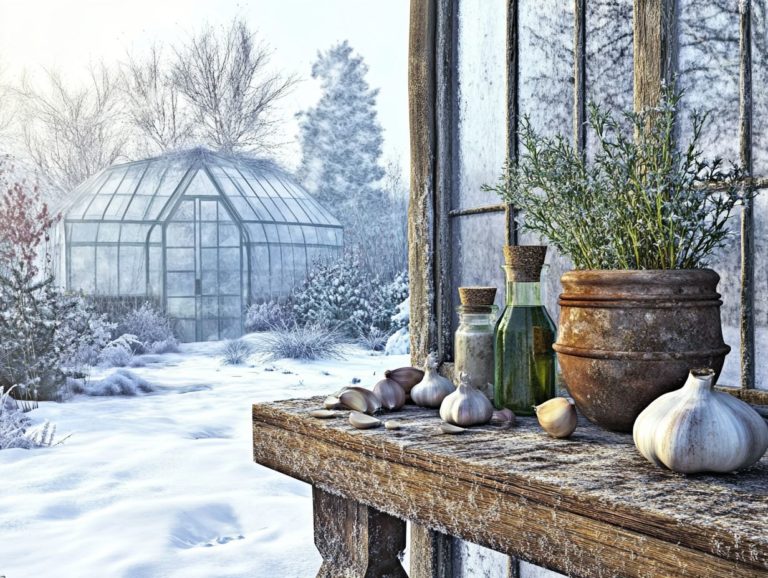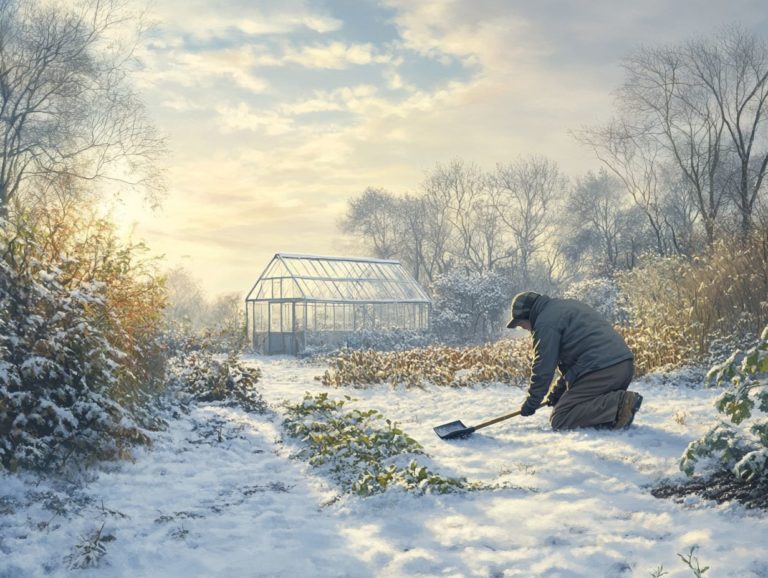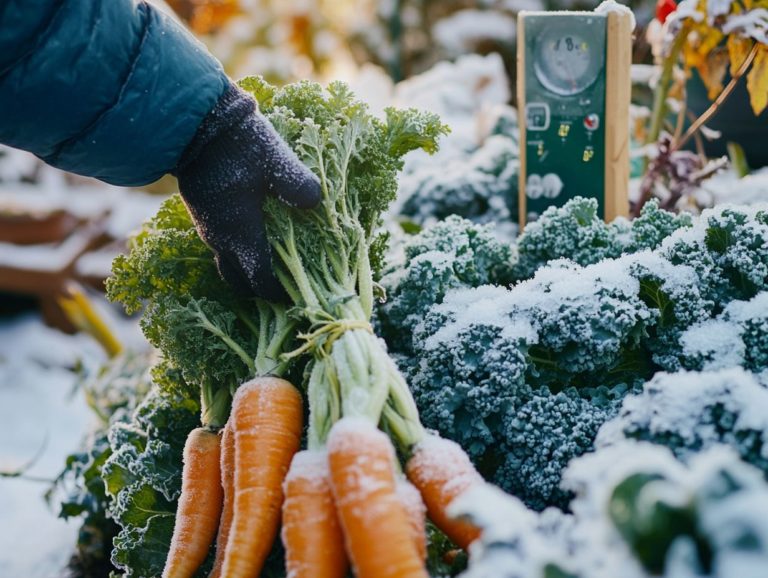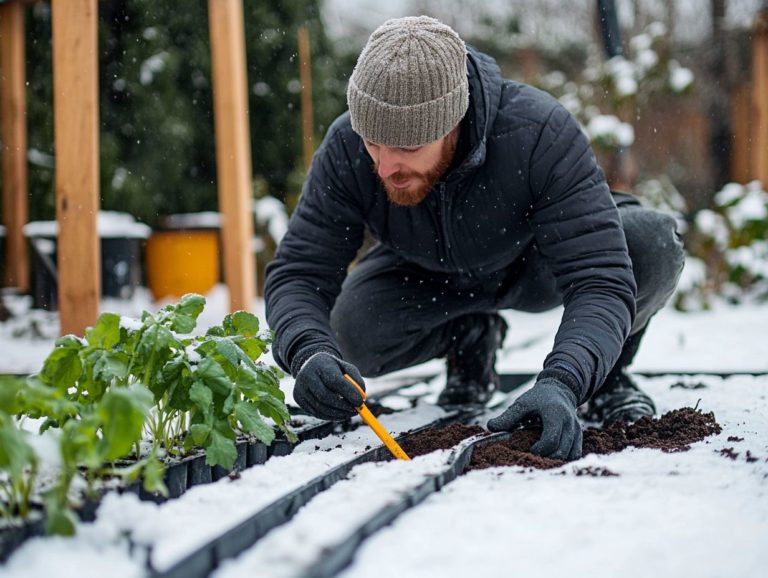How to Compost in Cold Weather?
Don’t let the cold stop you! Composting in winter is not just possible; it s a game-changer for your garden and the planet. It’s incredibly beneficial for your garden and the environment.
As temperatures drop, it’s essential for you to understand how the composting process evolves, particularly during winter. This article delves into what happens to your compost during winter, the advantages of maintaining your compost pile in the colder months, and the challenges you might encounter along the way.
You’ll find practical tips and alternative methods designed to help your compost flourish, even when the thermometer dips. Prepare to embrace winter composting with confidence!
Contents
- Key Takeaways:
- Understanding Composting in Cold Weather
- Benefits of Composting in Winter
- Challenges of Composting in Cold Weather
- Tips for Successful Winter Composting
- Alternative Methods for Composting in Winter
- Frequently Asked Questions
- How do I start composting in cold weather?
- What should I do with my compost during freezing temperatures?
- Can I continue to add materials to my compost in cold weather?
- How often should I turn my compost in cold weather?
- Can I use my finished compost in cold weather?
- What are some other tips for composting in cold weather?
Key Takeaways:
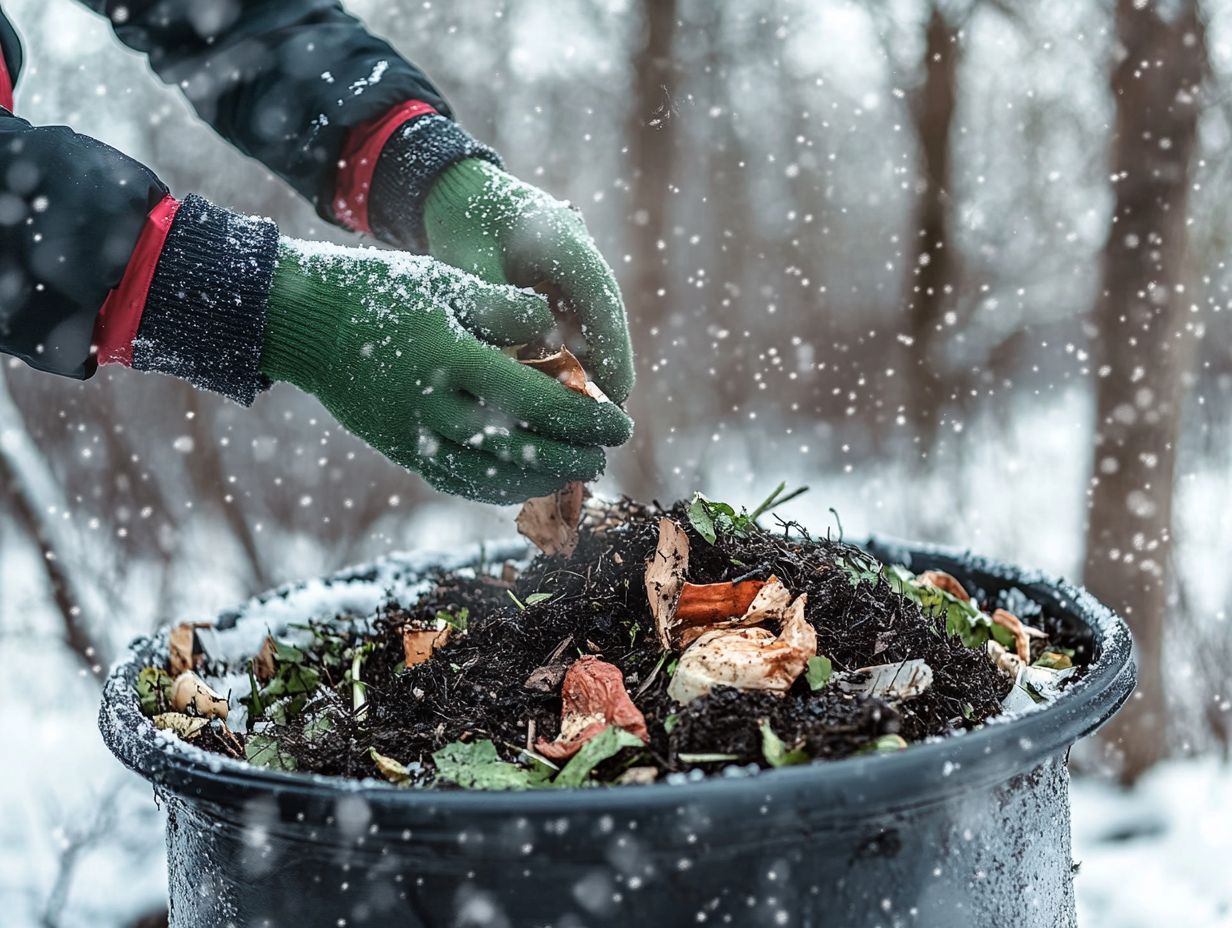
- Get ready to make the most of your composting journey, even in cold weather!
- Composting in cold weather is possible with the right strategies.
- It reduces waste and enhances soil quality.
- You can overcome challenges like slower decomposition with key tips.
Understanding Composting in Cold Weather
Understanding how to use compost in cold-weather gardening is vital for anyone aiming to manage food scraps efficiently while ensuring that composting remains effective during the winter months.
In areas like Ontario, Canada, where temperatures can plummet, adapting your composting techniques becomes crucial. This ensures you maintain an active compost pile that continues to break down organic matter throughout the year, especially with materials like greens and browns.
With the right combination of materials greens, browns, and a secure, animal-proof setup you can achieve successful composting even in the harshest conditions. This effectively wards off pesky visitors like raccoons, coyotes, opossums, and squirrels.
What Happens to Composting in Cold Temperatures?
In colder temperatures, composting slows down. This is due to reduced activity of tiny organisms that help break down your compost.
When the mercury drops, you ll notice that microbial activity takes a hit, resulting in longer breakdown times for your kitchen scraps and yard waste. To keep your compost pile thriving during the winter months, consider insulating it to retain heat adding straw bales around the edges can work wonders.
Maintaining adequate moisture is essential, as the chill can dry out your materials. Covering the pile with a tarp can help retain moisture while protecting it from ice and snow.
Incorporate greener materials rich in nitrogen to boost microbial activity. This way, you can ensure that the composting process continues, albeit at a slower pace, even in the frigid climate.
Benefits of Composting in Winter
Composting in winter presents a multitude of advantages that can greatly enhance your waste reduction efforts and improve garden soil quality. By effectively utilizing food scraps and organic matter during the colder months, you set the stage for richer, healthier garden soil as spring arrives.
This practice not only reduces waste but also fosters a thriving ecosystem in your garden.
Reducing Waste and Improving Soil Quality
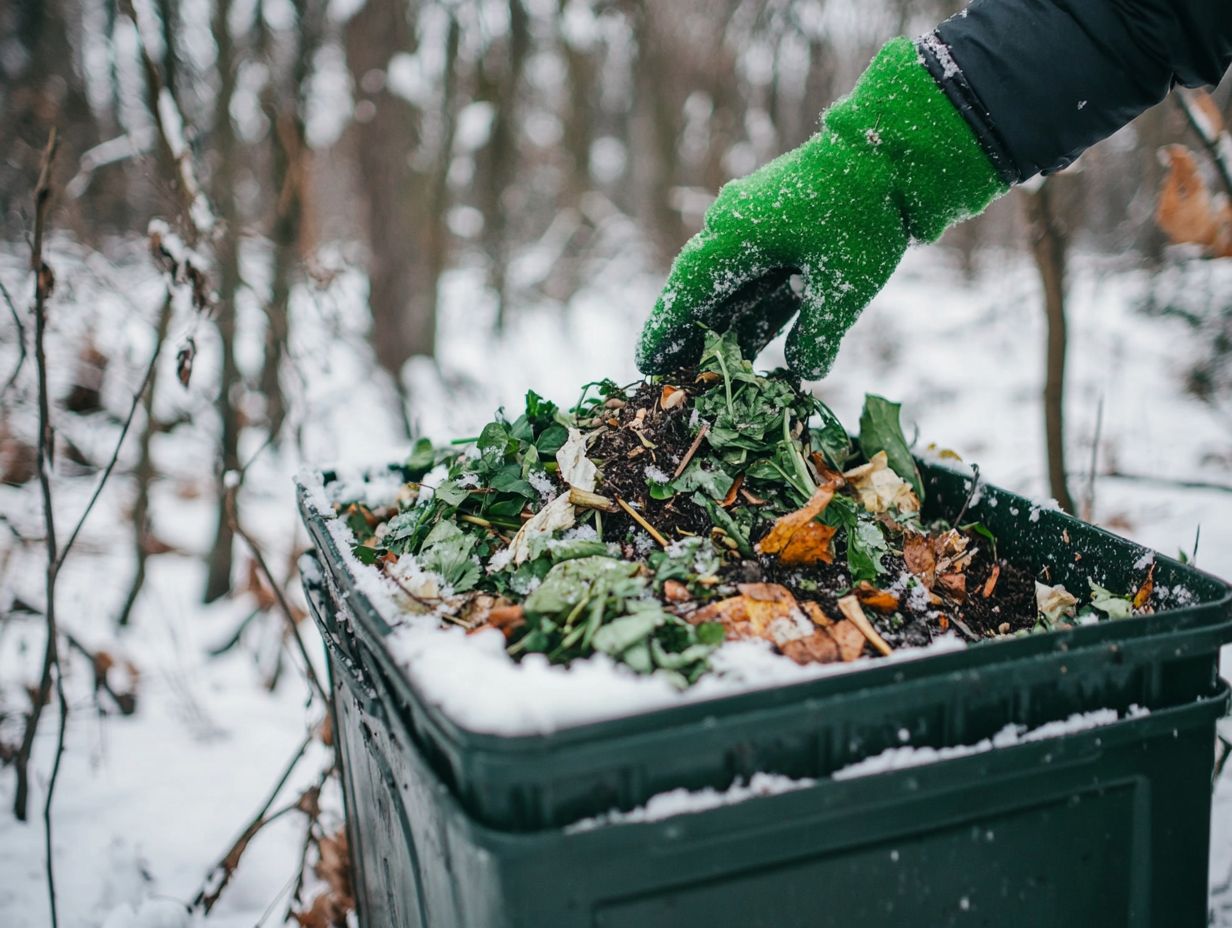
By effectively composting food scraps and organic matter during winter, you can significantly reduce waste while enhancing the quality of your garden soil for the planting seasons ahead.
This sustainable practice minimizes the amount of organic waste that finds its way to landfills. It also produces a rich, nutrient-dense amendment from food scraps for your soil.
Items like vegetable peelings, coffee grounds, eggshells, and garden clippings can seamlessly contribute to your compost pile, breaking down into a dark, earthy material that nourishes your plants.
Even in the chill of winter, you can employ methods such as trench composting or using a compost tumbler or galvanized trash can to encourage decomposition despite the colder temperatures. For effective composting in these conditions, consider the top 10 composting tools for cold climates. By maintaining a balanced mixture of ‘greens’ and ‘browns’, you can ensure your compost continues to thrive, ready to enrich your garden come spring.
Start your winter composting adventure today and watch your garden thrive!
Challenges of Composting in Cold Weather
Composting in cold weather can be quite the endeavor, presenting you with a series of challenges related to temperature, moisture, and oxygen levels. To overcome these hurdles, check out winter composting tips for cold climates to help you maintain the right temperature, manage moisture levels, and ensure there’s adequate oxygen supply.
Neglecting these factors might lead your compost pile to become a smelly mess or, worse, fail to decompose properly. However, with a bit of attention and care, you can turn these challenges into opportunities for achieving a successful composting experience, even in chilly winter conditions.
Learn How to Overcome Common Challenges
Common obstacles to composting in cold weather include maintaining optimal temperature and managing moisture levels. Ensuring sufficient oxygen supply is also critical. Fortunately, understanding the benefits of using compost in cold climates can help you effectively navigate these hurdles with strategic planning and the right composting techniques.
To tackle the warmth issue, consider using insulated compost bins that help retain heat. Additionally, placing your bin in a sunny spot can give it an extra boost.
Effective moisture management is crucial; adding carbon-rich materials like dry leaves can help balance out excess moisture, creating an ideal compost mix. Regularly turning your compost pile or using aeration tools will introduce oxygen, speeding up the decomposition process.
Don’t overlook the importance of using animal-proof bins to keep unwanted scavengers at bay, preserving the integrity of your materials. With these thoughtful strategies in place, you can foster a successful composting experience, even when winter shows its harsh side.
Tips for Successful Winter Composting
For successful winter composting, embrace effective strategies to keep your compost pile active. By managing temperature, moisture, and oxygen levels, you can significantly influence the decomposition process, even during the chill of winter months.
These factors are essential for ensuring your compost thrives during the colder season.
Key Strategies for Maintaining a Compost Pile in Cold Conditions
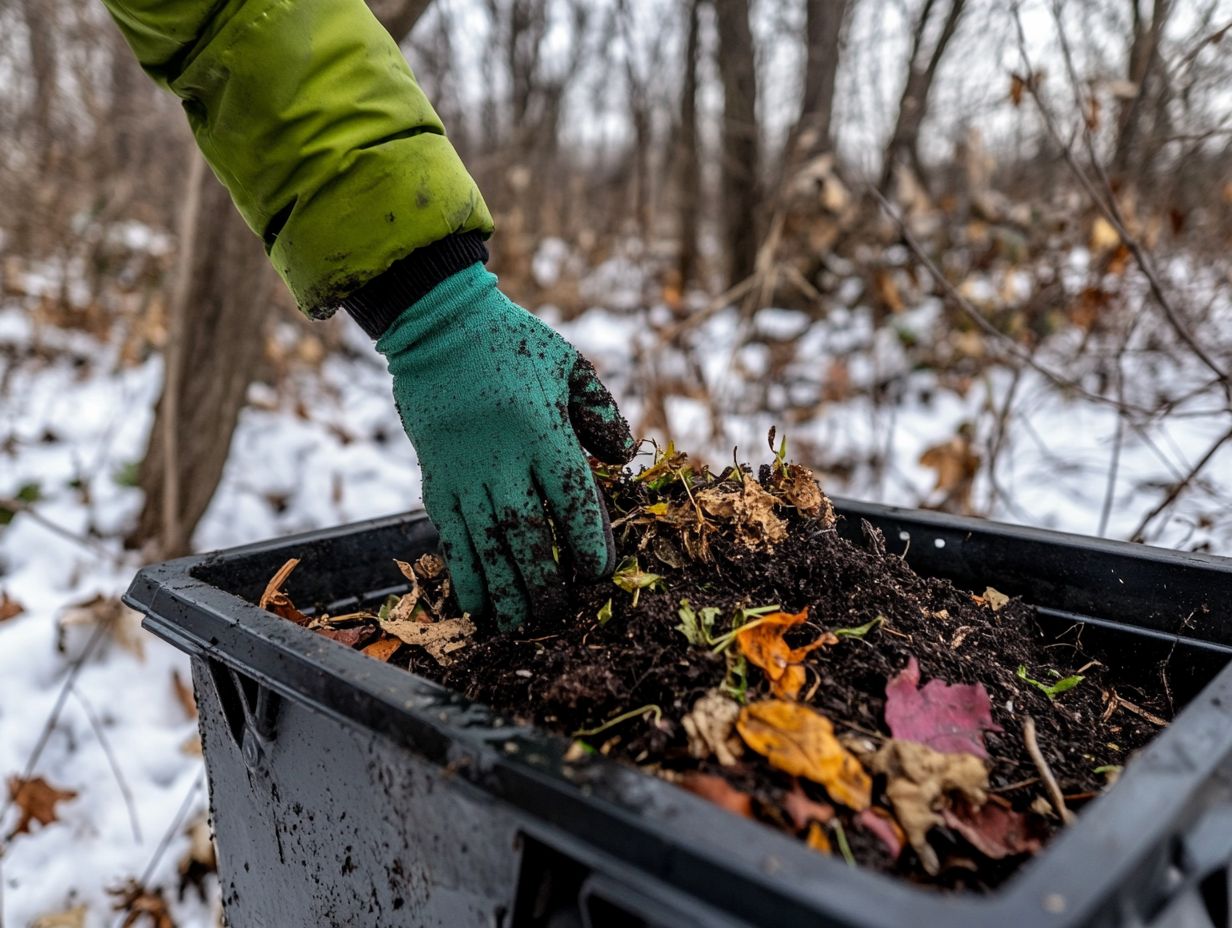
Key strategies for maintaining your compost pile in cold conditions involve closely monitoring the temperature and ensuring the right moisture content. Facilitating adequate oxygen flow is crucial to keep the decomposition process thriving, even when temperatures drop.
Effective layering of greens like vegetable scraps with browns such as dry leaves or straw is essential for achieving the right balance of green and brown materials. Embracing hot composting techniques not only accelerates the breakdown of organic matter but also generates heat, which is particularly vital when the outdoor temperature plummets.
Incorporating insulating materials, like old blankets or burlap, around your compost can help retain warmth. Regularly turning the pile promotes microbial activity and breaks up clumps, enhancing airflow.
By diligently monitoring the compost’s moisture levels, you can ensure it remains damp but not soggy, allowing the composting process to thrive, even in challenging winter weather.
Alternative Methods for Composting in Winter
Exploring alternative composting methods in winter can provide effective solutions if traditional outdoor composting poses challenges. Consider options such as indoor composting or utilizing tools like a 5-gallon bucket to efficiently manage your kitchen waste throughout the colder months.
Start your winter composting journey now and turn waste into warmth!
Indoor and Alternative Outdoor Composting Options
Indoor and alternative outdoor composting options present versatile solutions for managing kitchen waste during winter. These methods ensure your organic materials are composted effectively, regardless of the weather. For example, consider using compact compost bins.
These methods reduce the amount of waste that ends up in landfills while providing a fantastic opportunity to enrich your soil with rich in nutrients compost. Among the popular indoor techniques, you have:
- Vermicomposting: Let worms work their magic on your food scraps!
- Bokashi: This method uses fermentation to handle even cooked and dairy products with ease.
If space is tight, look into compact compost bins designed for quick decomposition and easy access. For outdoor composting, adapt your methods for colder climates by using insulating materials or selecting compost types that thrive in lower temperatures. This approach allows the decomposition process to continue even in winter’s chill.
Frequently Asked Questions
How do I start composting in cold weather?
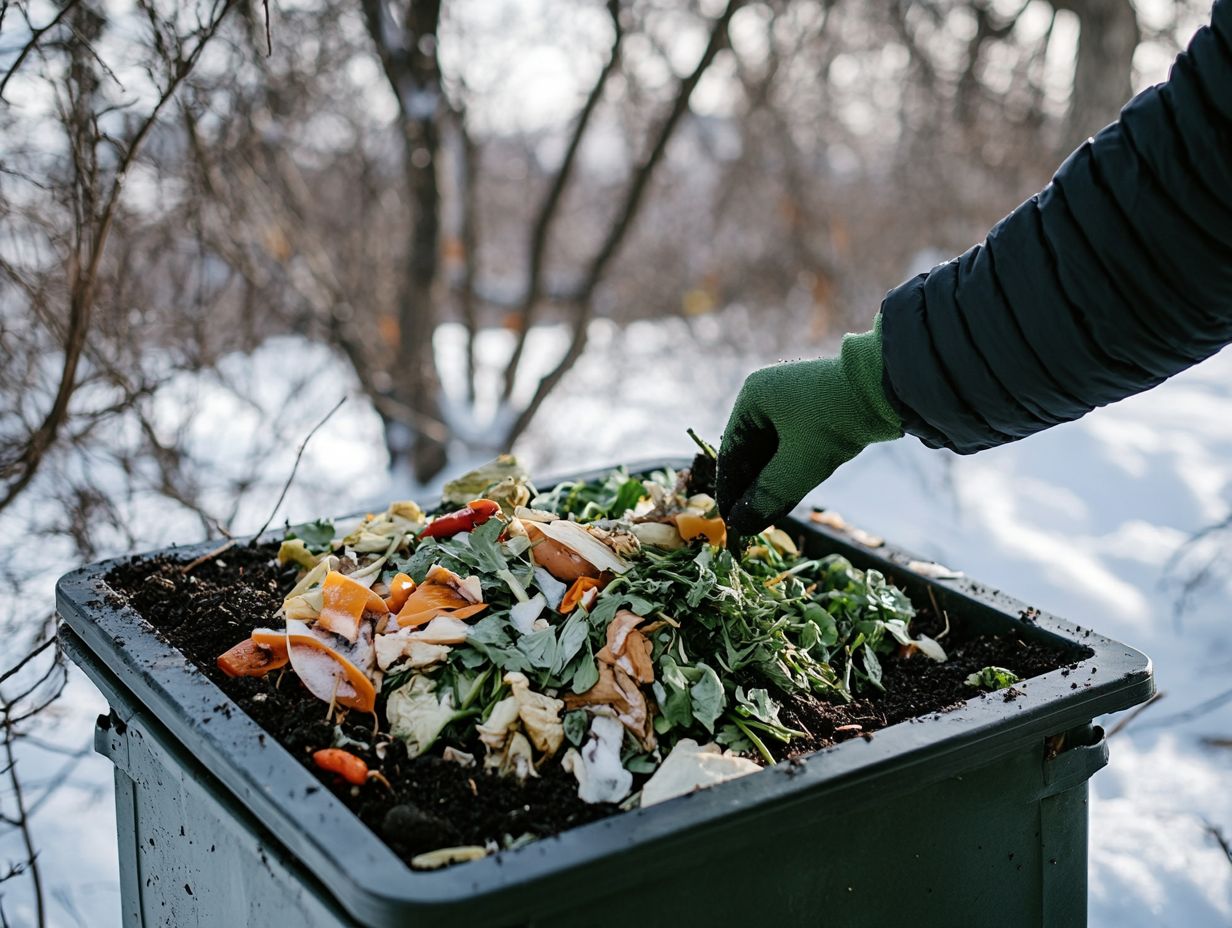
To start composting in cold weather, find a sheltered area in your yard. Begin by laying down a layer of straw or leaves. Then, layer your compost materials such as kitchen scraps, yard waste, and shredded paper on top. For more detailed guidance, check out the benefits of composting in cold weather. Continue adding layers and mix occasionally until your pile is about three feet tall.
What should I do with my compost during freezing temperatures?
Insulating your compost pile is key to keeping it active and thriving! Cover it with a tarp or layer it with straw or cardboard to help retain heat and prevent the pile from freezing solid.
Can I continue to add materials to my compost in cold weather?
Yes, you can keep adding materials to your compost during cold weather. Alternate between wet and dry materials, and mix them well to maintain activity. Adding a layer of finished compost or manure can also generate heat and keep the pile active.
How often should I turn my compost in cold weather?
In cold weather, turn your compost less frequently. Turning it too often releases heat and slows down decomposition. Instead, turn the pile every 4-6 weeks and mix the materials well to keep it active.
Can I use my finished compost in cold weather?
Yes, you can use your finished compost even in cold weather! Spread a thin layer over your garden beds to add nutrients and protect the soil from freezing temperatures. You can also store finished compost in a bin or covered pile until you are ready to use it.
What are some other tips for composting in cold weather?
Here are a few additional tips for composting in cold weather:
- Add a layer of shredded newspaper or cardboard on top of the pile to insulate it.
- Use a compost thermometer to monitor the temperature.
- Avoid adding large amounts of high-nitrogen materials, such as grass clippings, which can slow down decomposition in cold weather.
Start composting now for a healthier garden and make the most of your organic waste!

